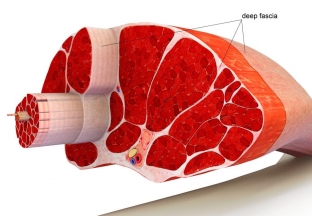Fascia – from superficial to internal layers – connects bones and muscles (tendons are considered part of the fascial system), bones (ligaments are also part of the fascial system), maintains the anatomical integrity of the internal organs, connects them together and ensures the stability of their position.
If you separate all anatomical parts of the body that are not fascia, you can get a perfect three-dimensional model of the body. For many years, the role of this tissue in the human body was ignored, but now, in the course of research, a number of interesting facts about fascial tissue have been established.
Fascia: a three-dimensional anatomical structure and its incredible properties
The unique functions of fascia in the body were described by Thomas Myers, whose article, published back in 2011, introduced readers to the research and methods of training the fascial network.
1. Fascia – 3d matrix
Fascia forms a continuous three-dimensional matrix that serves as the structural support for our organs, muscles, joints, bones and nerve fibers. This arrangement of the fascia also allows us to move in different directions.
Fascia – it is more than just connective tissue.
2. Fascia is involved in the transmission of power
Internal and external force is transmitted and distributed in the body mainly through the fascial network (as long as the force is not too great). Due to its viscoelasticity, fascia helps to prevent or minimize localized stress on a particular muscle, joint or bone, as well as absorbing the impulses generated by operating forces. This helps to protect the integrity of the body and minimize the amount of fuel used while driving.
3. Useful and harmful repetitions
Davis' Law states that soft tissue, which is a form of fascia, self-remodels (becomes denser and stiffer) along lines of tension. This provides short-term benefits and long-term consequences. If we regularly repeat a certain movement, the soft tissue is remodeled in the direction of the required movement, as a result of which it becomes stronger and more resistant to certain forces.
Such long repetitions strengthen the fascia along the load lines, but weaken it in other directions. This can lead to an increase in fascial tears or immobility of certain joints. The same can be said about the constant stay in a sitting or standing position, which is repeated for days, months and even years.

4. Hypertrophy and healing of fascial tissue
A 1995 study showed that mechanical stress (exercise) can promote hypertrophy of the ligaments, which are also a form of fascia. Research also confirms the ability of fascia to recover from ruptures. Thus, in some people, there was a complete recovery of function after rupture of the anterior cruciate ligament without surgery.
5. The fascia can also shrink
The fascia contains myofibroblasts that provide contractions similar to smooth muscle contractions, as well as numerous mechanoreceptors (nerve-tendon spindles, Ruffini bodies, mechanoreceptors resembling Pacini bodies). Theoretically, fascia contractions play an important role in balance and even energy expenditure.
The fascia can contract, just like the muscles.
6. Fascia can act independently of the central nervous system
The fascia is always under tension under the influence of gravity. This passive tension is called the myofascial tone of a person at rest, which Myers describes using the principle of tense integrity. Myofascial tone is a stabilizing component that helps us to be in a certain position and make various movements without thinking about them.
Because there are 10 times more propioceptors in connective tissue than in muscle, the fascial matrix helps us respond to environmental factors faster than we know it. An example of such a reaction would be pulling your hand away from a hot stove.
7. Mood affects fascia
Louis Shultz and Rosemary Feitis in their book The Endless Web: Fascial Anatomy and Physical Reality consider the issue of preserving emotion in our body, including in connective tissue. They believe that it is through the fascial network that emotions are transmitted, so in some cases, pain and inability to straighten the neck can be the result of emotional problems.
8. Fascia allows us to train the whole body
In his work, Myers demonstrates that connective tissue does not just cover muscles, bones, and organs, but does so in many layers. Thus, an understanding of the fascial network is necessary for the maximum improvement of the human physical form.
Further study of connective tissue will help shed light on its relationship with other body systems (nervous, musculoskeletal), as well as better study the characteristics of human movements and physical form. The use of myofascial meridians in training will increase endurance, improve mobility and strengthen joints.
Three-dimensional body training can be the key to comprehensive body strengthening, as opposed to isolated training, which is aimed at working out individual muscles or their groups.






Add a comment